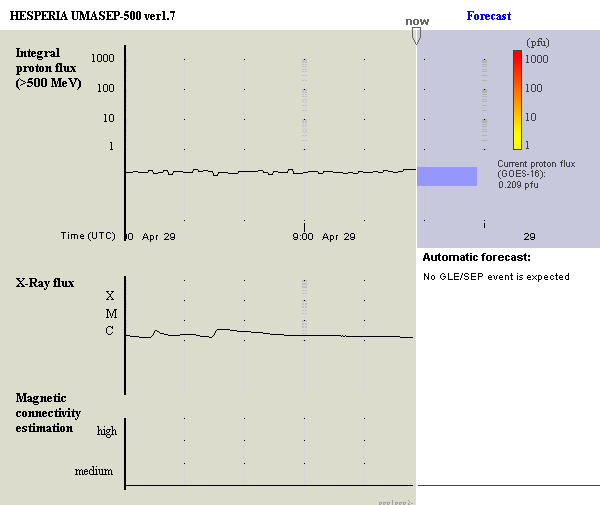Introduction of HESPERIA UMASEP 500
Solar energetic particles (SEPs) are sometimes energetic enough and the flux is high enough to cause air showers in the stratosphere and in the troposphere, which are an important ionization source in the atmosphere. >500 MeV solar protons are so energetic that they usually have effects on the ground, producing what is called a Ground Level Event (GLE).
One to the goals of the HESPERIA project is the development of a predictor of >500 SEP proton events at the near-earth (e.g. at geostationary orbit). In order to predict these events, the UMASEP scheme [Núñez, 2011, 2015] will be used. HESPERIA UMASEP makes a lag-correlation of solar electromagnetic (EM) flux with the particle flux at near-earth. If the correlation is high, the model infers that there is a magnetic connection through which particles are arriving. If, additionally, the intensity of the flux of the associated solar event is also high, then the HESPERIA UMASEP scheme issues a SEP prediction.
In the case of the prediction of >500 MeV SEP events, the implemented system, called HESPERIA UMASEP-500, correlates X-ray flux with each of the differential proton fluxes measured by the GOES satellites, and with each of the neutron density fluxes collected by neutron monitor stations around the world. When the correlation estimation surpasses a threshold, and the associated flare is greater than a specific X-ray peak flux, a >500 MeV SEP forecast is issued.

Description of plot
This figure shows the output image of the >500 MeV SEP predictor. This image presents three time series:
• The upper time series of this image shows the recent and the predicted >500 MeV proton flux. The current flux is at the left of the label "Now". The predicted >500 MeV flux is presented at the right of this label. The predicted intensity of the first 1 hour of the expected event are indicated by colors, which corresponds to certain intensity levels (in pfu) according to the vertical bar at the right.
• The middle time series in the left image of the forecast output shows recent solar activity in terms of soft X-rays.
• The time series at the bottom of the forecast output presents the empirically-estimated level of magnetic connectivity of the observed >500 MeV solar particles to Earth.
Validation
Regarding the prediction of >500 MeV SEP event, the forecast performance results of this tool for the period 1986-2016 may be summarized as follows: the POD was 50% (13/26), the FAR was 31.6% (6/19), and the AWT to the first NM's alert was 13 min.
Regarding the prediction of GLE events, the forecasting results for the most recent half of the evaluation period (i.e. 2000-2016) may be used to compare UMASEP-500 with those of the GLE Alert Plus. These results may be summarized as follows: the POD was 53.8% (7 of 13 GLE events); the FAR was 30.0% (3.10); the AWT to the first NM's alert was 8 min; and, the AWT to the GLE Alert Plus's warning was 15 min. The GLE forecasting results for the first half of the evaluation period (i.e. 1986-1999( are summarized as follows: the POD was 31.6% (6 of 19 GLE events); the FAR was 33.3% (3/9); and, the AWT to the first NM's alert was 13.3 min. There are no forecasting results of the GLE Alert Plus for this period.
For the whole evaluation period, the GLE forecasting performance may be summarized as follows: the POD was 40.6% (13 of 32); the FAR was 31.6% (6 of 19); and, the AWT to the first NM's alert was 10.5 min. Note that the FAR of the most recent period is similar to that of the oldest period (30.0% vs. 33.3%); however, the POD of the most recent period (i.e. 53.8%) is better than the POD of the oldest period (i.e. 31.6%). We do not know the reason for the better POD performance in the most recent period; nevertheless, we think that the use of a more recent and refined instrument technology and/or more experienced calibration procedures yields better forecasting performance.

 hesperia [dot] info [at] hesperia-space [dot] eu
hesperia [dot] info [at] hesperia-space [dot] eu



